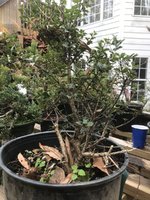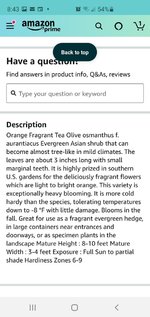@RKMcGinnis
The spines on the leaves are usually longer on Osmanthus, and I can tell heterophllyus usually from the leaf venation although I couldn't get a good look at that from your pics. Then I saw the hanging tag!
I fear coming off pedantic when I i.d. plants that people have misidentified, but I only want the person to know what they have so they can correctly cultivate it. After working for at nursery for 12 years, it was ingrained in me to use the botanical name first.
It's a cultivar I've never heard of before, so that's cool! It's supposedly a dwarf variety and flowers at an early age.
In my opinion, Osmanthus has some of the best fragrance around! Typically, the species 'fragrans' is the best, I'm not sure if heterophllyus is as fragrant though. The site I looked at said that your cultivar is good for bonsai! I'm not really seeing any dwarf characteristics on yours, hopefully it's not the straight species.
Care should be pretty similar to hollies. The only other thing I can add is that some Osmanthus can be temperamental to cold and are prone to some dieback, but they should bounce back from any issues like hollies.
Definitely. It is very common, I would say greater than 50% of small containerized plants are like this. But especially with meserveae hybrids and verticillatas to get appropriate pollenizers together; although I always wondered how these plants would perform once mature... Would one eventually choke out the other??? Last week I had a client ask me why only one plant of his hedge had berries and the others didn't, I had to tell him his hedge was Osmanthus and that he had mistakenly planted a female blue holly in there.
That's also how I got a crap load of Grace Hendrick Phillips boxwoods. I bought a bunch of 1 gallons (priced over $20 each

) and separated out the individual plugs, it was definitely worth it!






